Jun 2000, Vol. 4 No. 9
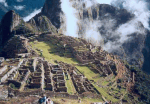 Arriving in the ancient city of Cuzco, my friend Stu and I felt a slight feeling of lightheadedness. There is a dramatic change in elevation from the sea level elevation of Lima to Cuzco’s 11,000 feet. After a good night’s sleep, which helped us adjust to the high altitude, we hired a guide, cook, and two porters ($250.00 for each of us) for the 4-day hike to the famous Inca ruins of Machu Picchu.
Arriving in the ancient city of Cuzco, my friend Stu and I felt a slight feeling of lightheadedness. There is a dramatic change in elevation from the sea level elevation of Lima to Cuzco’s 11,000 feet. After a good night’s sleep, which helped us adjust to the high altitude, we hired a guide, cook, and two porters ($250.00 for each of us) for the 4-day hike to the famous Inca ruins of Machu Picchu.
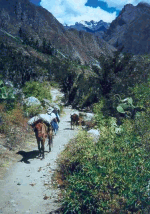 A bus dropped us at kilometer 88, a starting point for the ancient stone-built highway. After only a few hours on the trail, we began to see remnants of the incredible architecture left in the ruins of the Incas.
A bus dropped us at kilometer 88, a starting point for the ancient stone-built highway. After only a few hours on the trail, we began to see remnants of the incredible architecture left in the ruins of the Incas.
The Inca Highway climbs from about 9000 feet to 13-14,000. While we were physically fit, we still took Diamox as a precaution for altitude sickness. Having guides led us, setup camp and cook was a helpful indulgence. The Inca Trail is a challenging 30-mile high altitude hike.
 After two days of hiking, we reached “Dead Woman’s” pass. Climbing through canyons and along ridges, we traveled about 6 hours each day. The terrain was steep, with wonderful vistas and great rock formations.
After two days of hiking, we reached “Dead Woman’s” pass. Climbing through canyons and along ridges, we traveled about 6 hours each day. The terrain was steep, with wonderful vistas and great rock formations.
We approached Machu Picchu as the sun was lighting the “Sun stone” gate of the ancient city. We admired couch-size stones resting on one another without the use of mortar. We wondered if this remarkable place was similar to the pyramids of Egypt.
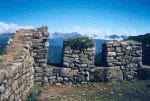 Most visitors reach this wondrous place in the high peaks of the Andes by train. We had strenuously traveled by foot following the trail of the Incas. The solitude of this ancient path was interrupted by the excited conversations of tourists when we boarded the train for the return trip to Cuzco.
Most visitors reach this wondrous place in the high peaks of the Andes by train. We had strenuously traveled by foot following the trail of the Incas. The solitude of this ancient path was interrupted by the excited conversations of tourists when we boarded the train for the return trip to Cuzco.
Our trip had begun in the Amazon basin of Peru. When rubber trees were being harvested and the earth of the rainforest was oozing in oil, Iquitos was the primary trading port along the Amazon River in Peru. After that, the river winding through the rainforest brought tourists and a new economy for the river.
 After recovering from a late night arrival in Lima, we caught a local flight to the gateway for travel along the Amazon. Transferring to a nearby dock, we boarded a 20-passenger tarp-covered launch for the hour or so journey into the jungle.
After recovering from a late night arrival in Lima, we caught a local flight to the gateway for travel along the Amazon. Transferring to a nearby dock, we boarded a 20-passenger tarp-covered launch for the hour or so journey into the jungle.
Close to the Andean headwaters of the Amazon, the river continued to widen until it spanned a half-mile. We traveled about 50-miles by boat, spending the first two nights at the Explorama Lodge on the Yanamono, a small tributary of the Amazon. The rustic palm-thatched camp was partially flood by the rainiest wet season in a decade. One of the two dining buildings was halfway submerged in the muddy water.
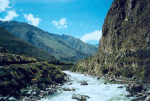 The pointed thatched-roof lodge had ten-foot partitions separating the bedrooms under the common roof. Shared toilets and several showers were scattered around the building. Beds were covered with mosquito netting in the sparsely furnished rooms, and each room conveniently had a chamber pot.
The pointed thatched-roof lodge had ten-foot partitions separating the bedrooms under the common roof. Shared toilets and several showers were scattered around the building. Beds were covered with mosquito netting in the sparsely furnished rooms, and each room conveniently had a chamber pot.
During our five-day visit in the rainforest we had planned to do some hiking. The floodwaters necessitated our using a dugout canoe to explore rainforest trails. Pink freshwater dolphins swam beside us while squirrel monkeys chattered in the canopy. We saw colorful “poison-arrow” toads, and a glimpse of the deadly fer-de-lance snake. Three-toe sloth climbed fig and fichus trees. Orchids and bromeliads were blooming.
 After two nights, we caught a boat to a similar lodge, the ExplorNapo, located on the Napo River, a tributary of the Amazon flowing from Ecuador. Again the flooding waters was lapping the floors of the dining hall. Planked walkways between the buildings were floating in the water. We would have to hold our hiking plans for the Inca trail to Machu Piccu.
After two nights, we caught a boat to a similar lodge, the ExplorNapo, located on the Napo River, a tributary of the Amazon flowing from Ecuador. Again the flooding waters was lapping the floors of the dining hall. Planked walkways between the buildings were floating in the water. We would have to hold our hiking plans for the Inca trail to Machu Piccu.
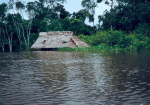 A capybara, one of the world’s largest rodents, startled me on the walkway as we headed out to visit some of the nearby villages. The native Yagua Indians are fisherman, and we watched them cast large nets in the river. Although their houses were built on stilts, high waters forced them to build platforms to keep themselves and their belongings dry.
A capybara, one of the world’s largest rodents, startled me on the walkway as we headed out to visit some of the nearby villages. The native Yagua Indians are fisherman, and we watched them cast large nets in the river. Although their houses were built on stilts, high waters forced them to build platforms to keep themselves and their belongings dry.
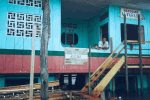 This adventure was not luxurious by any means. Accommodations were basic and food was a standard fare of pasta, and occasionally fish or chicken. Our last night was spent in an even more primitive camp. Our campsite consisted of opened-side tents on a raised wooden platform. There was a pit toilet and a solar shower. Drenched by rainfall during the night, the mosquito netting covering my bed collapsed. I used a shoestring to attach the broken tie.
This adventure was not luxurious by any means. Accommodations were basic and food was a standard fare of pasta, and occasionally fish or chicken. Our last night was spent in an even more primitive camp. Our campsite consisted of opened-side tents on a raised wooden platform. There was a pit toilet and a solar shower. Drenched by rainfall during the night, the mosquito netting covering my bed collapsed. I used a shoestring to attach the broken tie.
 The highlight of this camp was the canopy walkways over the jungle, an opportunity to view the rainforest at every level. This was one of the few times in the rainforest where we could stretch our legs rather than observing the sights from the wooden floor of a dugout canoe.
The highlight of this camp was the canopy walkways over the jungle, an opportunity to view the rainforest at every level. This was one of the few times in the rainforest where we could stretch our legs rather than observing the sights from the wooden floor of a dugout canoe.
Peru offers the opportunity to visit the jungle environment of the Amazon then trek into the ancient history of the Incas. We had enjoyed a great variety of landscapes.
